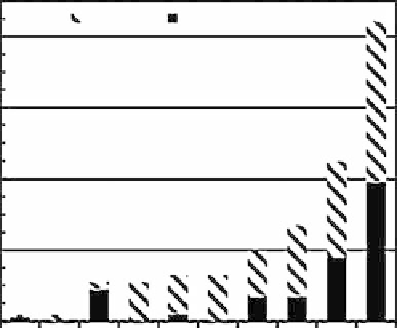Environmental Engineering Reference
In-Depth Information
Total
Install/YR
8.000
6.000
4.000
2.000
0
99
01
03
Ye a r
05
07
FIGURE 10.11
Wind farm capacity in Texas, number installed/year and cumulative. Capacity installed in
2008 was estimated at 3,900 MW.
electronics package that can be scaled from small to megawatt wind turbines; a 1.5 MW direct-drive
generator, Northern Power Systems; a prototype multimegawatt low-wind-speed turbine, General
Electric; and others.
Another emerging market is village electrification in developing countries. It is cheaper to have
village power than to extend transmission lines. The primary source of energy will be renewable
energy: solar, wind, hydro, and biomass. Many of these will be hybrid systems with batteries and
diesel for firm power. Large lending institutions, such as the World Bank and national government
aid programs, now realize there is an alternative to large-scale projects for producing power. Also,
there are more manufacturers of small wind turbines, and manufacturers in the United States and
China expanded their production.
Landowners now harvest the wind much as they harvest the sun for food and fiber. Since financ-
ing for large wind power plants requires millions of dollars, the landowner usually leases the land
and receives a royalty from the energy produced by the wind turbines, similar to the oil and gas
industry. The difference is that the wind resource can be fully determined before large amounts of
money are invested, and even more important, the resource will not run out.
10.8 COMMENTS
Beside the emerging markets of distributed systems and village power, there are two other fac-
tors, which will increase the market: green power and reduction of pollution. People can purchase
green power at a premium, and a lot of that power generation is from one to a few wind turbines
(
Figure 10.12
)
or from wind farms. There are a number of urban areas, which are in nonattainment
for clean air, and one way to reduce pollution is by production of electricity from renewable energy.
The reduction of carbon dioxide emissions per the Kyoto Treaty is part of many nations' regu-
lations. As trading in CO
2
becomes regulated in the United States, electricity produced by wind
turbines will become more valuable. Then wind energy will be the most cost-competitive power
source on the market.
There are some other wind applications of interest in terms of commercial systems and prototype
testing. These are the production of hydrogen, compressed air storage, pumped hydro, a stand-alone
electric-electric system for making ice, and desalination. There are also wind hybrid systems for
telecommunications and remote military installations. Many of these sites are only accessible by
helicopter, so fuel costs are high.

Search WWH ::

Custom Search